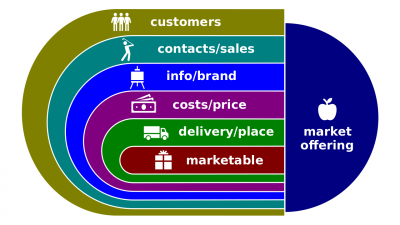Marketable
A marketing mix (alternatively known as product model, marketable compound, and, when already marketed, marketed compound; hereinafter, the Mix) is a model representing distinguishable components of any marketable. In other words, the Mix is a combination of components of a marketable that a business controls in order to influence consumers to purchase this marketable.
Contents
Components
Deliverable
deliverable, which can be divided in an unpackaged deliverable and packaging
Delivery
- Product delivery. The action of delivering marketables either ordered or for sale. Delivery personnel may be incorporated and important for this delivery.
Charge
- Product charge. A payment asked for a marketable. Not only its price, but also financing and acceptable payment methods may be incorporated in and important for this charge.
Presentation
- Product presentation. The proffering or giving of a marketable to its potential consumers, particularly, through product manuals, official website, and public relations. Branding is the marketing practice of creating a name, symbol, or design that identifies and differentiates a marketable from other marketables.
Basic tools
Several business tools are used to capture the Mix in marketing products.
The 4P's
- Product refers to the deliverable that its seller offers for sale. This may include its features, benefits, style, design, branding, packaging, services, warranties, guarantees, life cycles, investments and returns.
- Price refers to the total cost to customer to acquire the product, and may involve both monetary and psychological costs such as the time and effort spent in acquisition. The product charge such as list pricing, discount pricing, special offer pricing, credit payment or credit terms".
- Place refers either to the physical location where a business carries out business or the distribution channels used to reach markets. They include the direct or indirect channels to market, geographical distribution, territorial coverage, retail outlet, market location, catalogues, inventory, logistics, order fulfillment, virtual stores such as a call center and a website.
- Promotion refers to the marketing communications mix used to make the offer known to potential customers and persuade them to investigate it further.
The 4C's
Product
Consumer wants and needs A company will only sell what the consumer specifically wants to buy. So, marketers should study consumer wants and needs in order to attract them one by one with something they want to purchase.[32][34] Price
Cost Price is only a part of the total cost to satisfy a want or a need. The total cost will consider for example the cost of time in acquiring a good or a service, a cost of conscience by consuming that or even a cost of guilt "for not treating the kids".[32] It reflects the total cost of ownership. Many factors affect cost, including but not limited to the customer's cost to change or implement the new product or service and the customer's cost for not selecting a competitor's product or service.[35] Place
Convenience In the era of Internet,[34] catalogues, credit cards and phones, consumers neither need to go anywhere to satisfy a want or a need nor are they limited to a few places to satisfy them. Marketers should know how the target market prefers to buy, how to be there and be ubiquitous, in order to guarantee convenience to buy.[32][36] With the rise of Internet and hybrid models of purchasing, Place is becoming less relevant. Convenience takes into account the ease of buying the product, finding the product, finding information about the product, and several other factors.[37] Promotion
Communication While promotion is "manipulative" and from the seller, communication is "cooperative" and from the buyer[32] with the aim to create a dialogue with the potential customers based on their needs and lifestyles.[36] It represents a broader focus. Communications can include advertising, public relations, personal selling, viral advertising, and any form of communication between the organization and the consumer[citation needed].
The 4A's
Extended tools
The 7P's
- In addition to the 4P's, the following three P's might be added to describe the Mix of a service,
- People (or personnel) refers to the personnel that stand for the service. In the professional, financial or hospitality service industry, people are not producers, but rather the products themselves.
- Process refers to a set of activities that results in delivery of the product benefits including greetings and customer service actions.
- Physical evidence refers to the tangibles or non-human elements of the service encounter, including equipment, furniture and facilities.
